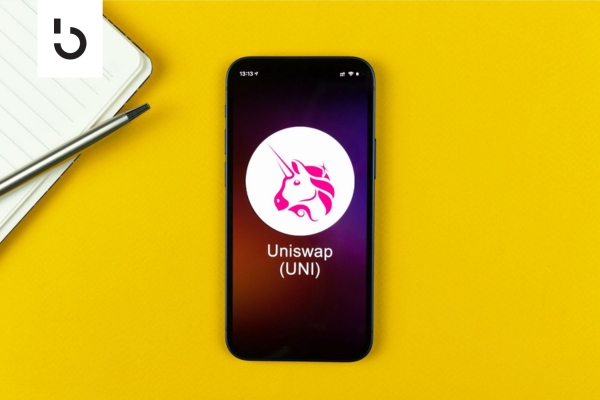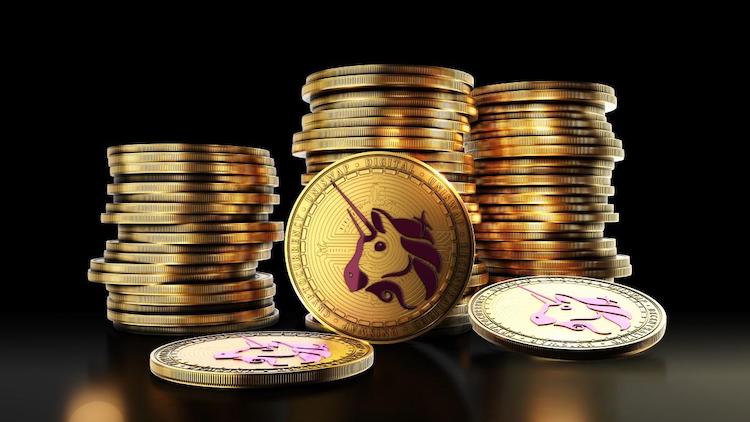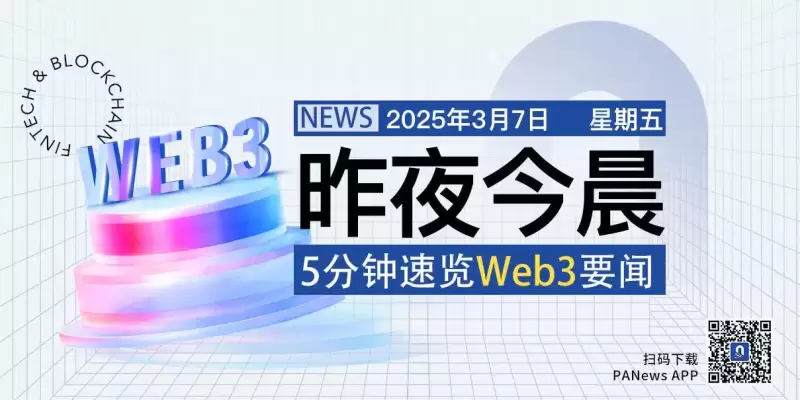 |
|
 |
|
 |
|
 |
|
 |
|
 |
|
 |
|
 |
|
 |
|
 |
|
 |
|
 |
|
 |
|
 |
|
 |
|
Uniswap, the leading decentralized exchange with a robust user base, high trading volumes, and ample liquidity, emerges as a strong competitor in the DEX landscape, constantly innovating with new features and upgrades. Its native token, UNI, represents a compelling investment opportunity for those looking ahead in decentralized finance, acknowledging the competition and potential risks involved. Boasting the largest share of the DEX market, reduced trading fees, and an expanding user base, Uniswap commands the DeFi revolution. However, formidable competitors seek to claim its throne, raising pertinent questions about UNI's future and the potential dethroning of Uniswap.


Key Takeaways
- Uniswap is a leading DEX with a solid user base, high trading volumes, and excellent liquidity.
- Uniswap constantly innovates and improves its protocol to offer new features and upgrades, making it a strong competitor in the DEX space.
- The Uniswap token (UNI) is a promising investment for those interested in the future of decentralized finance, provided they are aware of the competition and the risks involved.
With the largest share of the DEX market, low trading fees, and a growing user base, Uniswap is the undisputed leader of the DeFi revolution.
But plenty of competitors want to claim the throne.
This leads to a few natural questions: Is Uniswap’s UNI still a good investment? Who might unseat it? Is that even possible?
Read on to learn the answers to these questions and more.
Table of Contents
- What Is Uniswap?
- Why Is Uniswap Important for Investors?
- What Is the Uniswap Token (UNI)?
- Uniswap Fees and Revenues?
- Uniswap Revenue vs. Competitors
- Who Benefits from Uniswap Fees?
- Uniswap Tokens and Fundraising
- Uniswap Liquidity Pool Revenues
- Investor Takeaway
- Frequently Asked Questions
What Is Uniswap?
Uniswap is a decentralized exchange (DEX) that supports automated trending for crypto tokens. It doesn’t have a centralized order book, and it relies on an intelligent algorithm to set prices on hundreds of ERC-20 token pairs available on the platform.
In 2024, it remains the most prominent DEX, handling the lion’s share of trading volumes in that market. This volume brings significant benefits to its users. For example, with such a significant Total Value Locked (TVL), liquidity is rarely a concern for Uniswap users.
For comparison, here is a quick look at the recent TVL for major DEXs (i.e., the total value of crypto locked in their platforms):
Because Uniswap was the first of its kind, it enjoys a first-mover advantage today. Users also appreciate the simple interface, which makes Uniswap easy to use.
Add in Uniswap's security and the platform’s focus on privacy—it doesn’t ask for personal information on sign-up—and you can see the reasons for its enduring popularity.
Why Is Uniswap Important for Investors?
Uniswap is the most successful DEX based on the Automated Market Maker (AMM) model.
Moreover, maintaining high revenues and stability proves that a crypto exchange can work without a centralized order book or market maker.
While 2022 was a challenging year for everyone in the crypto market, developments in 2023 have shown that there is still room for hope and optimism. And 2024 is already looking quite positive, with UNI exceeding expectations and trading at an all-time high price above $12.
As of this writing, trading volumes on Uniswap have increased dramatically, and the DEX continues to earn over $129 million in 30-day average fees. Due to its generous fee structure, LPs earn more on this DEX than on other exchanges.
Pricing in Decentralized Exchanges
Traditional centralized exchanges (CEXs) like Coinbase and Binance rely on an order book—a list of all the buyers and sellers for a specific security—to set the exchange's prices.
Decentralized exchanges (DEXs) like Uniswap use mathematical formulas (AMM) to price assets. This technology removes the need for a middleman to set asset market prices.
Because of this, where CEXs were slow to add new tokens (they had to vet each one carefully), Uniswap can automatically support any Ethereum-compatible token with enough supply and demand.
The original version of the Uniswap protocol was launched on the Ethereum mainnet in November 2018. Since then, there have been several incremental upgrades:
- Version 1: Allowed users to trade between ETH and any ERC-20 tokens.
- Version 2: Launched in May 2020, this version added new features and functionality like increased decentralization, flash swaps, and ERC-20 pools, allowing direct exchange between Ethereum-based tokens.
- Version 3: Launched in May 2021, it includes improved security and efficiency, as well as features like concentrated liquidity, range orders, NFTs, and flexible fees.
- Version 4: Currently under development, version 4 is expected to be an incremental upgrade focusing on QoL changes, such as a better UI, built-in wallet, NFT aggregation, and possibly a batched auction system to combat MEVs.
- UniswapX: This is a complementary protocol to version 4, focused on finding the best liquidity sources by creating a market for swap fulfillment.
What Is the Uniswap Token (UNI)?
UNI is the native token of the Uniswap protocol. Its stated purpose is to serve as the protocol's governance token, though our thesis is that investing in UNI is like buying Uniswap “stock.” (Read more on our crypto investing approach.)
UNI was launched without an ICO or token sale in September 2020. Instead, community members, protocol users, and liquidity providers received free airdrops of up to 400 UNI (worth approximately $1500 at the time and $4500 now). Synthetix founder Kain Warwick called the airdrop a “galaxy brain move” since it rewarded early users for their loyalty.

Uniswap Fees and Revenues
As a DEX, Uniswap’s revenue/fee structure is better for users than centralized exchanges like Coinbase or Binance.
Uniswap version 2 had a flat fee of 0.3% on all swaps and added the option for a “fee switch.” This option would allow the protocol (i.e., the Uniswap company itself) to take a percentage of the fees collected from trades if switched on. (Like retained earnings, this could theoretically be paid out to UNI tokenholders.)
When Uniswap launched version 3, they kept the fee switch option in place. The main change was the addition of different fee tiers, ranging from 0.01% to 1%.
In general, the swap fees charged depend on the relative stability of the trading pairs. For most pairs, the standard fee of 0.30% will apply. The fee is lowered to 0.05% for stable pairs, with the most stable pairs charging a 0.01% fee. If you swap high-risk or “exotic” pairs, expect a maximum fee of 1%.
The decision to turn on the fee switch can only be taken through an open vote among the protocol governance forums (i.e., UNI token holders must approve it). In June 2023, a proposal to enable protocol fees on all swaps and trades was narrowly defeated by 45.32% “No” votes against 42.34% “Yes” votes.
In February 2024, another attempt was made to turn on the fee switch and distribute rewards among UNI holders. Although initial trends seemed highly positive, the proposal suffered a temporary setback, defeating in a snapshot vote on March 8.
The multiple rejections indicate that the Uniswap community does not favor drastic protocol changes. Due to this cautious approach, all the revenues generated to date have been paid to liquidity providers.
This means that the Uniswap “company” is not retaining any “revenue.” However, this could easily change shortly – the proposal is currently undergoing amendments and could be put to a final on-chain vote in mid-April 2024.
Unlike the protocol fee switch, Uniswap Labs charges a fee on certain token swaps. First invoked in October 2023, the fee is a flat 0.15% interface fee levied on swaps involving any two of the following tokens: ETH, WETH, WBTC, DAI, USDC, EURO, USDT, GUSD, LUSD, XSGD, and agEUR.
TLDR: While a successful “fee switch” would provide dividend-like rewards for UNI token holders, they would come at the expense of LPs who power the Uniswap engine, so there’s both risk and reward.
The History of Uniswap Fees
Uniswap started to take off after the launch of version 2 in 2020, which allowed users to trade any ERC-20 token pairs. (Before that, version 1 only allowed users to trade ERC-20 tokens against ETH.)
Monthly revenues for liquidity providers climbed from $4.8 million in July 2020 to $35 million by December that year. However, the real spike in Uniswap revenues occurred in 2021, as version 3 upgrades added further efficiency and features.
The protocol gained widespread acceptance, and monthly revenues quickly exceeded $100 million by March 2021. Uniswap hit a new peak in May, with revenues awarded to liquidity providers reaching an all-time high of $285 million.
Uniswap fees declined briefly in Q3 2021 before regaining steam in Q4, rallying to $180 million in November. In 2022, Uniswap broke several records in fees collected.
In June 2022, the average daily fee earned on the protocols reached $4.87 million, surpassing Ethereum at $4.8 million. By August 2022, Uniswap's 7-day average fees were nearly double that of Ethereum ($8.7 million vs $4.07 million).
However, the meltdown in the broader crypto market in Q3 and Q4 2022 wiped out most of these gains. It took the crypto market several quarters to reverse the decline.
After the chaos of 2022, the broader crypto market saw signs of recovery in 2023. For the first time in Q1, 2023, Uniswap overtook Coinbase in quarterly spot trading volumes, with trades worth $155 billion against the latter’s $145 billion.
They maintained the lead in Q2, posting $110 billion in trades over Coinswap’s $90 billion. However, Coinbase narrowly retook the top spot in Q3 and widened the gap after a resurgence in Q4, with trades worth $154 billion.
Although Uniswap’s volumes were significantly lower in Q4 2023, the DEX still had a remarkable year overall. It matched Coinbase in terms of annual trading volumes, with both exchanges effectively tied for 2023 at $465 billion each.
Annualized revenues earned by liquidity providers on Uniswap in 2023 amount to around $356 million, far ahead of the nearest competitor protocol, Aave ($117 million).
These trends show the relative resilience of DEX platforms over their CEX counterparts. After the catastrophic collapse of centralized exchanges like FTX, there is renewed interest in the DEX market, and Uniswap is positioned to capitalize on it.
Uniswap has also benefited from the increased activity on Ethereum in 2023 following its transition to Proof-of-Work.
Uniswap Revenue vs. Competitors
Several contenders have emerged in the last 3-4 years, providing stiff competition for the DEX throne. Uniswap is no longer the only popular DEX in the market. Let’s take a quick look at some of the DEX competitors:
- SushiSwap and PancakeSwap: Both are clones of Uniswap, built using the latter’s open-source source code. They offer similar features and similar/lower fees as a competitive advantage.
- Compound: Launched in 2017, this specialized DEX creates tokens for assets locked on the platform. The tokens allow users to earn interest while retaining the freedom to transfer and use the assets on other platforms.
- Curve Finance: Another specialized DEX focused exclusively on stablecoins like USDT, USDC, DAI, and TUSD. Users can stake their stablecoins in liquidity pools or swap between coins on the trading platform.
- dYdX: Another DEX, dYdX, launched in 2017, giving additional options to users in the form of derivative trading. It briefly overtook Uniswap as the top DEX regarding trading volume in September 2021.
Let’s compare Uniswap’s revenues against the contenders:
Before 2022, the rise of clones like PancakeSwap and SushiSwap did eat a chunk out of Uniswap’s business. These clone DEXs accrued $1.5 billion in revenues before the 2022 downturn despite launching after Uniswap.
However, both projects have faced a decline since the market crash. Sushiswap has only generated $40 million in revenues since Q4 2021. Meanwhile, the latest version of Pacakeswap – V3 – has accrued $12 million in revenues since its September 2023 launch.
Since 2021, dYdX has been steadily eating away at the market share of Uniswap since 2021. With the advantage of an order book, derivative trading, and a massive airdrop of the dYdX token, the protocol has rapidly closed in on Uniswap in recent years.
However, in terms of crypto fees generated from trades, none of these DEX contenders comes close to Uniswap's numbers. Since the end of Q1 2023, the platform generated $656 million in fees.
The nearest is dYdX, with nearly $70 million in 365 days, followed by Pancakeswap at $49 million. Trader Joe is just behind in fourth at $47.6 million, followed by Sushiswap a distant fifth at $29 million, just a fraction of the revenues generated by Uniswap for its liquidity providers.
Who Benefits from Uniswap Fees?
As we mentioned, 100% of the revenues generated from trading fees on Uniswap are deposited directly into liquidity providers' pools.
Neither the team behind the protocol nor the holders of the UNI governance token earn anything from the revenue generated on Uniswap.
The Uniswap Fee “Switch”
In 2023, GFXLabs, one of the contributors to the Uniswap project, advanced a proposal to turn on the fee switch and move a portion of the revenues to protocol treasury.
The proposal would have implemented a protocol fee of 20% of the collected fees from version 3 and turned on the fee switch on version 2. Based on projections released by GFXLabs, the proposed 1/5th fee would have generated over $52 million in revenue for the protocol across six months (based on the average fees generated in May 2023).
In theory, part or all of this revenue could be shared with UNI holders—like a stock dividend. Of course, any such move would also directly impact liquidity providers' revenue generation, who could leave for competing exchanges.
For many UNI investors, that risk would outweigh the reward. This was reflected in the July vote on the proposal, which was narrowly defeated. 45.32% of the votes went to the “no fee” camp.
The remaining 54.68% of the vote was split between people in favor of the one-fifth fee (42.34%) and people in favor of a lower one-tenth fee (12.3%). A minority (0.04%) voted to charge one-sixth of the fees.
On February 23, 2024, a second identical governance proposal with a 20% fee was submitted. Over the coming weeks, the value of UNI doubled as initial surveys or “temperature checks” indicated that the proposal would be approved.
However, on March 8, UNI holders rejected the amendment in a snapshot poll, with 59.89% (30 million UNI) voting to “Reject” and 40.11% (20 million UNI) voting to “Accept”.
The actual on-chain vote on the proposal will happen sometime in mid-April 2024. Following the defeat in the snapshot, the proposal is undergoing multiple audits to reverse UNI token holder sentiment and garner more support before being put to an on-chain vote.
The outcomes of multiple snapshots and on-chain votes by the UNI community indicate considerable support for a fee switch. However, the DAO is very cautious, and the proposals may have to lower the fee structure to succeed.
Uniswap Tokens and Fundraising

Uniswap Labs, founded by Hayden Adams, manages the protocol. The company recently conducted two funding rounds, raising over $176 million.
- Andreessen Horowitz (a16z crypto) led the Series A round in August 2020, which raised $11 million. Eight investors participated, including Union Square Ventures, A. Capital Ventures, SVA, and Variant Alternative Income Fund.
- The Series B round ran in October 2022. Conducted during the crypto winter, it was a remarkable success, bringing in $165 million.
Since the company currently does not take any trading fees, the primary source of value/revenue for the project is its native token, UNI. Although most tokens were airdropped to community members, liquidity providers, and protocol users on launch, 20% of the UNI supply has been kept in reserve.
The total supply of UNI is 1 billion. At the time of writing, UNI had a price of $12.85, putting the value of the 21.27% reserve at $2.73 billion, which is set aside for the team behind the Uniswap project. Depending on UNI’s market price, they can sell these holdings for cash to run the business — but of course, that will only last so long.
If the protocol fee switch activation is passed in a future vote, the revenues for the protocol and team behind Uniswap could increase by up to $50 million/year. In the past, such proposals have sought to spend these additional revenues to fund new projects and education programs.
Uniswap Liquidity Pool Revenues
Anybody with available crypto assets can become a liquidity provider or LP. A decentralized exchange cannot function without LPs, making the trades possible. Thus, Uniswap wants to encourage as many people as possible to become LPs.
In an AMM exchange, the counterparty is not one person but a pool of funds supplied by many different users. The smart contract sets the price and executes the trade.
This is where LPs enter the equation: the cryptos they lock into Uniswap provide liquidity to the smart contract. Instead of a buyer and seller, you have a buyer and a liquidity pool, which is made up of people.
In Uniswap, these pools are usually based on token pairs like ETH/BTC or SOL/DAI. To participate in a liquidity pool, you deposit equal amounts of the two tokens in a 50:50 ratio (for example, 50% ETH/50% BTC).
Since liquidity providers are integral to an AMM, the company handsomely rewards them. Between January 2024 and March 2024, Uniswap earned $250 million in fees, all of which were paid to the LPs.
It can pay to play in the pool. One reason why turning on the fee switch is problematic is that LPs may simply go to competitor DEXs to make more money.
Investor Takeaway
Uniswap faces an uncertain but hopeful future. Though it has a vast user base, it is losing market share to competing DEXs that still need the AMM model. Many LPs face an uphill battle to retain profits in AMMs due to “impermanent loss.”
With the rise of knockoffs and non-AMM alternatives, Uniswap has its work cut out: It must continue to innovate, add new features, and improve its user experience in all areas where it has traditionally performed well.
Still, Uniswap has a history of innovation and delivering significant protocol upgrades. (Uniswap ships.) It is also far more accessible for the average user to understand and use than tech-heavy sites like dYdX.
And of course, the outcome of the fee switch proposal could have a big impact on the course of the company: while it would provide dividend-like rewards for UNI token holders, those would come at the expense of LPs who power the Uniswap engine.
Of course, much will also depend on the crypto market's future trajectory. Uniswap remains our top pick for the long-term DEX winner, so we continue to hold UNI in our Future Winners Portfolio.
FAQs
Is Uniswap a good investment?
The Ethereum blockchain is the most popular and vibrant crypto ecosystem globally. It will also likely receive significant upgrades to efficiency, gas fees, and transaction times over the next several years, making it hard for other Layer 1 chains to overtake it.
As the pre-eminent decentralized exchange on Ethereum, with access to over 7,951 trading pairs, Uniswap still has much to offer investors interested in staking their assets in liquidity pools.
Our investment thesis is that buying and holding UNI is like a long-term investment in the Uniswap company. Despite the challenges listed above, we believe in Uniswap’s ability to execute and currently have the token as a part of our Future Winners Portfolio.
How does Uniswap make money?
Uniswap earns money by charging a 0.3% fee for each trade on the platform. Currently, liquidity providers receive a reward proportionate to their token contributions. The company also earns revenue via its holdings of the governance token UNI, which can be appreciated with changes in the crypto markets.
However, in the present scenario, nearly 50% of LPs on Uniswap are losing money due to impermanent loss. In a highly volatile crypto environment, a token's loss in value is not compensated by the transaction fees on the DEX.
This causes a loss in dollar value to investors on the platform. In the future, this may change with an improved algorithm. However, as long as they fail to address impermanent loss, Uniswap will remain a sub-optimal investment option for liquidity providers.
Should you trade on Uniswap?
DEXs like Uniswap require technical expertise: You must own a crypto wallet like Metamask and understand how to navigate gas fees. In addition, unlike centralized exchanges, the interface may provide little hand-holding. With those caveats, Uniswap is one of our top DEX picks for buying and selling ERC-20 tokens.
Subscribe to Bitcoin Market Journal to stay informed about all your options when investing in cryptocurrencies.
Disclaimer:info@kdj.com
The information provided is not trading advice. kdj.com does not assume any responsibility for any investments made based on the information provided in this article. Cryptocurrencies are highly volatile and it is highly recommended that you invest with caution after thorough research!
If you believe that the content used on this website infringes your copyright, please contact us immediately (info@kdj.com) and we will delete it promptly.
-

-

-

-

-

-

-

- Ripple (XRP) Introduces Its RLUSD Stablecoin to the Stablecoin Market
- Apr 03, 2025 at 04:00 pm
- Ripple introduced its RLUSD stablecoin to the stablecoin market through its launch on Kraken cryptocurrency exchange. The USD-pegged stablecoin aims to boost its cross-border payment functions and integrate with the payment platform.
-

-

- Bitcoin (BTC) Price Consolidation May Be Precursor to a Market Drop, Analyst Says
- Apr 03, 2025 at 03:55 pm
- Bitcoin has seen a notable price consolidation over the past few weeks, trading between the $84,000 and $86,000 levels. Despite the initial surge in price, the cryptocurrency has faced a decline of 3.7% in the past week and nearly 10% in the past month, signaling a period of stagnation in its upward momentum.




























































